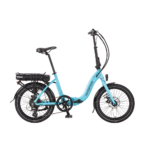So ... following on from this thread, if you bought a new Kalkhoff Agattu, how long would you expect the chainwheel and the motor drive sprocket to last?
How long should my chainwheel last?
- Thread starter danfoto
- Start date
I'll judge from my experience with a Lafree with the old Panasonic unit which retained the original items at 6000 miles when I sold it and was used unchanged for a further over two years by the buyer.
So since the new unit has a high power mode which is used occasionally and the bike is a little heavier, I'd expect at least 5000 miles, but that's for a hub gear model with chain kept greased. With derailleur I can't really judge, though I'd want at least 3000 miles. From what I've been hearing though, they aren't always lasting that long.
So since the new unit has a high power mode which is used occasionally and the bike is a little heavier, I'd expect at least 5000 miles, but that's for a hub gear model with chain kept greased. With derailleur I can't really judge, though I'd want at least 3000 miles. From what I've been hearing though, they aren't always lasting that long.
My Pro Connect is a 2008 model which doesn't have as higher level of assistance as the later Panasonic units and has 8 Speed hub gears. My chain, chain wheel, motor and rear sprockets lasted for around 9 to 10 thousand miles, I can't remember the exact figure, but it certainly over 9000 miles.So ... following on from this thread, if you bought a new Kalkhoff Agattu, how long would you expect the chainwheel and the motor drive sprocket to last?
Cheers, chaps. I was informed this morning by Matt at 50 Cycles that that amount of wear at 1600 miles is not grounds for a warranty claim. He also said that the motor sprocket is worn, so I'm the best part of £40 out of pocket, plus the cost of a new chain. At least he had the grace to not charge me p&p, for which I'm thankful.
Whatever, can anybody suggest what's caused the deformation on the "no-load" side of the teeth?
ETA - the chainwheel on The Lady Wife's Agattu is heading the same way, and due to her illness it's only done 800 miles!
Whatever, can anybody suggest what's caused the deformation on the "no-load" side of the teeth?
ETA - the chainwheel on The Lady Wife's Agattu is heading the same way, and due to her illness it's only done 800 miles!
Last edited:
Chainwheel teeth aren't symetrical - there should be a shallow "hook" on most of them.
Any pics?
What did the chain measure at when you replaced it?
Any pics?
What did the chain measure at when you replaced it?
Really? I need to see a pic to understand what you mean.Chainwheel teeth aren't symetrical - there should be a shallow "hook" on most of them.
Your slightest wish ...Any pics?


It didn't, because I haven't yet. No point putting a new chain on knackered sprockets.What did the chain measure at when you replaced it?
Right, so what is your chain wear tool showing then?It didn't, because I haven't yet. No point putting a new chain on knackered sprockets.
For wear on the rings - it's hard to tell from that angle of photo but check this pic:-

Big ring - worn a bit but ok for a while yet.
Middle ring - very worn, needs replacing.
Small ring - no wear at all.
Last edited:
I always found the middle chain ring went first despite using it as little as possible. My thought was they are of a softer metal. One reason I went with the NuVinchi & carbon belt drive. Time will tell if this was an error of judgment.
What do you use for a lubricant? On your chain, I hasten to add.Cheers, chaps. I was informed this morning by Matt at 50 Cycles that that amount of wear at 1600 miles is not grounds for a warranty claim. He also said that the motor sprocket is worn, so I'm the best part of £40 out of pocket, plus the cost of a new chain. At least he had the grace to not charge me p&p, for which I'm thankful.
Whatever, can anybody suggest what's caused the deformation on the "no-load" side of the teeth?
ETA - the chainwheel on The Lady Wife's Agattu is heading the same way, and due to her illness it's only done 800 miles!
The wear on the non pressure side of the teeth is strange. I know the motor sprocket on these Panasonic units tends to pull the chain around the chain wheel, but due to the torque sensor, the contact pressure should always be on the leading edge of the tooth.
No need to measure the chain wear, it's definitely shot. Whether that's the cause or the effect of the peculiar tooth wear is anybody's guess.
I would have expected a worn chainwheel to have "hooked" teeth as in the middle chainring in amigafan's picture, but these are pretty evenly deformed on both leading and trailing sides of the teeth, and that's something I've never seen before in 50-odd years of meddeling with chain drives. BTW, don't forget this is a single chainwheel and a 1/8" chain.
Whatever, according to 50 Cycles it's normal wear and tear, so having reluctantly paid my £40 for a new chainwheel and motor sprocket, it's shut up and put up time ...
I would have expected a worn chainwheel to have "hooked" teeth as in the middle chainring in amigafan's picture, but these are pretty evenly deformed on both leading and trailing sides of the teeth, and that's something I've never seen before in 50-odd years of meddeling with chain drives. BTW, don't forget this is a single chainwheel and a 1/8" chain.
Whatever, according to 50 Cycles it's normal wear and tear, so having reluctantly paid my £40 for a new chainwheel and motor sprocket, it's shut up and put up time ...
TomMy Pro Connect is a 2008 model which doesn't have as higher level of assistance as the later Panasonic units and has 8 Speed hub gears. My chain, chain wheel, motor and rear sprockets lasted for around 9 to 10 thousand miles, I can't remember the exact figure, but it certainly over 9000 miles.
In the 2008 era of our ProConnect bikes, the standard Panasonic 41 Tooth chainwheel had whopping great teeth, 3.0 mm thick, which required 1/8" wide chain to fit over the teeth.
Before our time, "hub gears" were often associated with Sturmey Archer, and I believe they were often fitted with similar, wide tooth, sprockets requiring 1/8" chain. Maybe this was also true of the early Shimano Nexus hubs.
1/8" chain = 3.17 mm, and fits nicely over 3.00 mm teeth.
At the rear wheel, the Shimano hub gears had already begun to use narrower sprockets by the time of our Nexus 8 speed hubs. Sprockets ranging from 16 teeth to 23 teeth were shown as alternatives on the hub parts list; all with a tooth thickness around 2.25 mm.
This is a close fit for the narrower, 7/8 speed derailleur, 3/32" chain = 2.38 mm, but runs well if the single front chainwheel is carefully aligned with the single sprocket on the hub gear.
3/32" chain = 2.38 mm and fits nicely over 2.20 mm teeth, and can be used on 2.25 mm teeth if the alignment is good.
The last of the three wheels that make up the "wearing parts" is the motor sprocket.
In 2007/8, the standard motor sprocket was 9 tooth, and had a thickness of 2.18 mm.
Comfortable for use even with 3/32" chain, and masses of tolerance with 1/8" chain.
So on our 2008 ProConnects, the wear on the chainwheel is spread around 41 teeth that are 3.00 mm thick. I presume that the chainwheel teeth at 12 o'clock are exerting a pull on the chain that is the sum of the rider effort and the motor effort, and nice to spread that across 3mm of width.
Life changed in 2009'ish with the advent of the sportier models using 9/10/11 speed derailleurs. Suddenly the chain width had to come down to 11/128" to suit the derailleur cassette, and nothing wider could be used.
11/128" chain = 2.18 mm and fits nicely over 1.98/2.00 mm wide teeth.
So we now saw the advent of the "narrow" Panasonic chainwheels with teeth that are 2.00 mm thick. Some models still used 41 teeth and other models now used 35 teeth.
Even the motor sprockets at 2.18 mm were too thick (just) for the narrow 9/10/11 speed chains, occasionally being used in error and not releasing the chain smoothly.
Of course, for bikes using 1/8" chain, it is not always easy to spot whether the chainwheel has 3mm wide teeth or 2mm wide teeth. Both will run, but you would expect a higher wear rate on the narrower teeth.
What I cannot answer through lack of experience is whether Panasonic ever made the 35 tooth chainwheel with fat, 3mm, teeth. I suspect not.
Danfoto, how many teeth on your chainwheel, and (if you have access to a vernier) how thick are they ?
I am guessing that it might be 35 teeth that are 2mm thick.
So, in the worst case, the workload in your case might be spread around 35 teeth that are 2mm thick, compared to Tom Tillson with 41 teeth that are 3mm thick.
Sorry this was so long.
James
It's good that it is so long and comprehensive James, excellent details of the overall situation.Sorry this was so long.
James
My understanding and experience is that if you change your chain before it wears then you shouldn't need to change your chain ring(s).
I have yet to wear out a chain ring or a sprocket on my 3 speed Brompton that has done over 6000 miles. I have changed the chain about four times.
I have just serviced a friends Brompton and had to change both. In this case the chain had been left on there for several years.
Note though four chains cost about £40 and a new sprocket and main chain ring for a Brompton are about £50.
Jerry
I have yet to wear out a chain ring or a sprocket on my 3 speed Brompton that has done over 6000 miles. I have changed the chain about four times.
I have just serviced a friends Brompton and had to change both. In this case the chain had been left on there for several years.
Note though four chains cost about £40 and a new sprocket and main chain ring for a Brompton are about £50.
Jerry
Last edited:
Jerry, I note what you say and have no argument with it as far as it goes, but ...
You change your Bromton chains every 1500 miles and your sprockets are fine. My Agattu has done a total of 1600 miles from new, and both chain and chainwheel are stuffed. According to 50 Cycles, the motor sprocket is worn too and needs replacing along with the chain. I haven't checked the back sprocket yet because at the moment I really don't want to know.
What is getting to me is 50 Cycles' assertion that 1600 miles is an acceptable life for the chainwheel and the motor sprocket given normal utility cycling use and "maintenance", by which I mean a wipe with an oily rag when it looks in need of one, and fairly regular applications of 3-in-1.
And before anybody points out that that isn't proper chain maintenance, I know. The chain and spockets on my Thorn Sherpa get properly maintained because it's a "cyclist's" bike. I would bet that those on my Agattu are treated no worse than those on most utility bikes, and probably better than many.
Whatever, I really can't be arsed to up-end the Agattu and take the chainguard off just to measure the sprockets when I hope to have new ones here before long. I'll therefore come back to this later in the week when I can compare these sprockets with the replacements.
You change your Bromton chains every 1500 miles and your sprockets are fine. My Agattu has done a total of 1600 miles from new, and both chain and chainwheel are stuffed. According to 50 Cycles, the motor sprocket is worn too and needs replacing along with the chain. I haven't checked the back sprocket yet because at the moment I really don't want to know.
What is getting to me is 50 Cycles' assertion that 1600 miles is an acceptable life for the chainwheel and the motor sprocket given normal utility cycling use and "maintenance", by which I mean a wipe with an oily rag when it looks in need of one, and fairly regular applications of 3-in-1.
And before anybody points out that that isn't proper chain maintenance, I know. The chain and spockets on my Thorn Sherpa get properly maintained because it's a "cyclist's" bike. I would bet that those on my Agattu are treated no worse than those on most utility bikes, and probably better than many.
Whatever, I really can't be arsed to up-end the Agattu and take the chainguard off just to measure the sprockets when I hope to have new ones here before long. I'll therefore come back to this later in the week when I can compare these sprockets with the replacements.
D
Deleted member 4366
Guest
You can't really make any comparisons between how a hub-motored and crank-motored bike wear their chains and sprockets.
A hub-motor adds its power directly to the wheel, so it subtracts overall power from the chain/sprockets, while as the crank-motor adds to it. Therefore, assuming something like a 1:1 relationship between rider and motor and an average power of 200w, the hub-motored bike will have 100w going through the chain and the crank-drive bike will have 200w going through it - twice as much. In a hill-climbing situation, the difference could go up to five times as much, so it's logical that you'll wear out your chain/sprockets much faster on a crank-drive bike, but whether 1500 miles is normal is debatable.
A hub-motor adds its power directly to the wheel, so it subtracts overall power from the chain/sprockets, while as the crank-motor adds to it. Therefore, assuming something like a 1:1 relationship between rider and motor and an average power of 200w, the hub-motored bike will have 100w going through the chain and the crank-drive bike will have 200w going through it - twice as much. In a hill-climbing situation, the difference could go up to five times as much, so it's logical that you'll wear out your chain/sprockets much faster on a crank-drive bike, but whether 1500 miles is normal is debatable.
Exactly. That's my thoughts in a nutshell.... it's logical that you'll wear out your chain/sprockets much faster on a crank-drive bike, but whether 1500 miles is normal is debatable.
Apparently the new sprockets are now en route, so hopefully we shall soon see how new compares with old ...
Tom
In the 2008 era of our ProConnect bikes, the standard Panasonic 41 Tooth chainwheel had whopping great teeth, 3.0 mm thick, which required 1/8" wide chain to fit over the teeth.
Before our time, "hub gears" were often associated with Sturmey Archer, and I believe they were often fitted with similar, wide tooth, sprockets requiring 1/8" chain. Maybe this was also true of the early Shimano Nexus hubs.
1/8" chain = 3.17 mm, and fits nicely over 3.00 mm teeth.
At the rear wheel, the Shimano hub gears had already begun to use narrower sprockets by the time of our Nexus 8 speed hubs. Sprockets ranging from 16 teeth to 23 teeth were shown as alternatives on the hub parts list; all with a tooth thickness around 2.25 mm.
This is a close fit for the narrower, 7/8 speed derailleur, 3/32" chain = 2.38 mm, but runs well if the single front chainwheel is carefully aligned with the single sprocket on the hub gear.
3/32" chain = 2.38 mm and fits nicely over 2.20 mm teeth, and can be used on 2.25 mm teeth if the alignment is good.
The last of the three wheels that make up the "wearing parts" is the motor sprocket.
In 2007/8, the standard motor sprocket was 9 tooth, and had a thickness of 2.18 mm.
Comfortable for use even with 3/32" chain, and masses of tolerance with 1/8" chain.
So on our 2008 ProConnects, the wear on the chainwheel is spread around 41 teeth that are 3.00 mm thick. I presume that the chainwheel teeth at 12 o'clock are exerting a pull on the chain that is the sum of the rider effort and the motor effort, and nice to spread that across 3mm of width.
Life changed in 2009'ish with the advent of the sportier models using 9/10/11 speed derailleurs. Suddenly the chain width had to come down to 11/128" to suit the derailleur cassette, and nothing wider could be used.
11/128" chain = 2.18 mm and fits nicely over 1.98/2.00 mm wide teeth.
So we now saw the advent of the "narrow" Panasonic chainwheels with teeth that are 2.00 mm thick. Some models still used 41 teeth and other models now used 35 teeth.
Even the motor sprockets at 2.18 mm were too thick (just) for the narrow 9/10/11 speed chains, occasionally being used in error and not releasing the chain smoothly.
Of course, for bikes using 1/8" chain, it is not always easy to spot whether the chainwheel has 3mm wide teeth or 2mm wide teeth. Both will run, but you would expect a higher wear rate on the narrower teeth.
What I cannot answer through lack of experience is whether Panasonic ever made the 35 tooth chainwheel with fat, 3mm, teeth. I suspect not.
Danfoto, how many teeth on your chainwheel, and (if you have access to a vernier) how thick are they ?
I am guessing that it might be 35 teeth that are 2mm thick.
So, in the worst case, the workload in your case might be spread around 35 teeth that are 2mm thick, compared to Tom Tillson with 41 teeth that are 3mm thick.
Sorry this was so long.
James
Thank you for posting that explanation James. I knew that the chain wheel and sprockets had been slimmed down, but not by that much. I've just checked my spare chain wheel and it seems to be one of the 3 mm ones. I've not got spare motor or rear sprockets, so it will be interesting to see how thick the material is when I get around to buying them.
Thinking about the Panasonic drive set-up for a moment. I don't think that the power assist will create any additional or accelerated wear on the chain wheel. It may do so on the chain and the rear sprocket, but not the chain wheel. Because of the way that the Panasonic drive is configured, the chain wheel simply acts as an idler as far as the power assist component is concerned. The only power element added to the system through the chain wheel is the rider's effort. This makes it very strange as to why danphoto's chain wheel has worn so quickly. I can understand accelerated chain and rear sprocket wear, because they transmit both rider effort and motor input, but not so the chain wheel. (I acknowledge that the thinner material will cause the component to wear faster than my 3mm thick chain wheel.)
TomThinking about the Panasonic drive set-up for a moment. I don't think that the power assist will create any additional or accelerated wear on the chain wheel. It may do so on the chain and the rear sprocket, but not the chain wheel. Because of the way that the Panasonic drive is configured, the chain wheel simply acts as an idler as far as the power assist component is concerned. The only power element added to the system through the chain wheel is the rider's effort. This makes it very strange as to why danphoto's chain wheel has worn so quickly.
I have been trying to get my head round this question of the chainwheel simply being an "idler" with respect to the power provided by the motor.
The obvious difference compared with a traditional "idler" is that the chainwheel is between the driving sprocket and the driven sprocket, whereas an idler is more commonly found in the slack section of chain after the driven sprocket.
Furthermore, the chain makes a complete change of direction (and more) between entering the chainwheel and leaving the chainwheel.
So, you would expect the chain to pull very tightly into the "well" between the teeth when you are on maximum assist.
If, say, the chainwheel were on the thin side or the soft side, then the effort from the motor could still influence the "wear" or "deformation" in the valley between the teeth, and may give rise to a burr forming.
Now add in a bit of rider effort, and the chain may move a little out of the valley between the teeth towards the bottom of the leading edge, and some wear (and burring) would now show in the bottom leading corner.
If this were an unpowered bike, using rider effort only, then the maximum wear would be much higher up the leading edge of the tooth, giving rise to the "hook" shape that is often seen.
The power component from the motor might be why Danfoto talks about wear being on both faces of the tooth.
I think that the power assist may therefore affect the position of maximum wear on the chainwheel, and must add a component of pressure in the valley between the teeth that could accelerate the wear caused by the rider.
For discussion.
James
Related Articles
-
 MTF Enterprises announces acquisition of EMU Electric Bikes
MTF Enterprises announces acquisition of EMU Electric Bikes- Started by: Pedelecs
-
 Wisper 806T folding bike wins Which? ‘Best Buy’
Wisper 806T folding bike wins Which? ‘Best Buy’- Started by: Pedelecs
-
 Sustrans calls for protected cycle lanes
Sustrans calls for protected cycle lanes- Started by: Pedelecs
-
 Amazon launch their first UK e-cargo micromobility hub
Amazon launch their first UK e-cargo micromobility hub- Started by: Pedelecs


